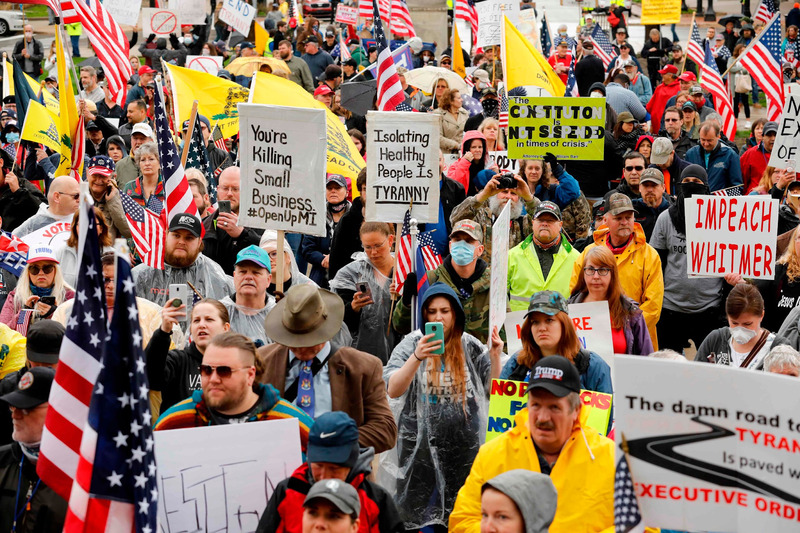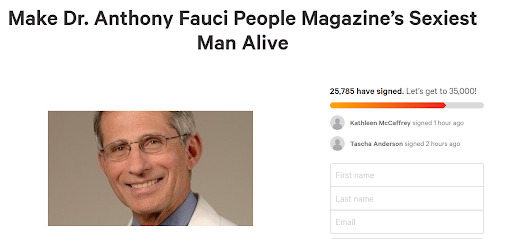Leadership and Governance during COVID-19
By Konrad Bostrom and Nicole Frey
In this essay we examine unusual government action, leadership during the pandemic, and the potential consequences of COVID-19 on future political practices. We use our own journal entries in combination with news articles to outline events that are relevant to our themes. This essay does not summarize everything that has happened throughout the pandemic; however, it is our hope that it allows the reader to better understand our experiences and interpretations during a world-changing event.
Protests
Anti-lockdown protesters have appeared in cities such as Lansing, Saint Paul, and Madison. In addition to spreading the SARS-CoV-2 virus, these protesters downplay science and promote individual freedom over community health. Anti-Vaccination advocates have joined some protests, rejecting the idea that the government should have a say in an individual’s health. Some conservative politicians supported the protests. Other activist groups are protesting during this time, mostly from their cars. Issues of housing security and releasing ICE detainees have drawn crowds. These protests reveal the importance of maintaining freedom of speech while considering safety.
Potentially Dangerous Leadership from President Trump
During a global pandemic, people rely on leadership for clarity and direction in getting through the difficult times. Leadership throughout the COVID-19 pandemic has come from many sources, and with different messages. This messaging has at times been unhelpful, or perhaps even harmful.
“President Trump has claimed that hydroxychloroquine prevents COVID-19, and that he might take it himself. This is potentially dangerous, and someone has already died taking chloroquine phosphate instead by accident” (Bostrom, April 4 2020).
The spread of misleading and incorrect information has continued throughout the pandemic. Trump and Pompeo have suggested that COVID-19 might be connected to a lab in Wuhan. Dr. Fauci has repeatedly stated how unlikely it is that the virus was “man made.” When conspiracy theories and miracle cures are treated as viable options, instead of last resorts, we get division within our country as well as negative health effects.
“The President of the United States of America has proposed drinking bleach could be a potential cure for the coronavirus” (Bostrom, April 24 2020).
It is no wonder that people are lost for leadership at this time. Some have even criticized Trump for using the crisis as an opportunity to campaign for re-election. His daily coronavirus briefings are aired on many major networks. Those that don’t show his briefing are criticized for not giving Americans access to medical information.
“President Trump has apparently insisted on putting his own name on the stimulus checks to Americans that could not receive direct deposits. This could delay the delivery by a few days, even though congress voted to provide $1200 in March” (Bostrom, April 15 2020).
It’s possible that Trump’s need to be associated with preventing COVID-19 and its fallout is harmful.
Alternative Sources of Leadership
For many Americans, Dr. Fauci has become the voice of reason and clarity. His direct, apolitical medical expertise has made him the most trusted official for COVID-19 information. Below are the results of a Morning Consult/Politico poll among registered voters. Here we can see that support for Dr. Fauci is bipartisan, and that people feel more satisfied with his delivery of information than those of the president and the CDC.
A Business Insider poll used a scale of 1 to 5 to measure trustworthiness. The poll had similar results: respondents gave Fauci the highest average score of 3.84 out of 5. Cuomo was second and received an average score of 3.29 out of 5. President Donald Trump was second to last, and scored 2.56 out of 5 on average. Forty-four percent of respondents rated Trump a 1 out of 5, compared with 20% who rated him a 5 out of 5. Most respondents rated Trump as a 1 or 2.
Some have decided to show their appreciation for Dr. Fauci by signing a petition to make him People Magazine’s Sexiest Man Alive.
Local vs. National Leadership
When discussing the stay at home order, Trump has claimed that the federal government has absolute power in opening up states, after previously declaring that state governments were responsible for dealing with the pandemic.
“I thought it was funny that our President told our governors that they were responsible for their own states, and individual states immediately organize themselves into groups that will coordinate how they open up. It seems like adding extra steps to a solution that needs to be the result of large-scale coordination” (Bostrom, April 18 2020).
In response to a lack of federal direction, some states have organized into regional groups aimed at opening their economies in safer phases. More recently, some eastern states have come together to purchase personal protective equipment.
“A University of Virginia professor believes that states are organizing regionally so that the president of the United States cannot push them around. To have such a disconnect between the president and the governors is crazy, especially when that disconnect is the result of different realities and understandings of science” (Bostrom, April 19 2020).
Since the beginning of the pandemic, more testing has been the key to reopening economic activity. We have also heard that a lack of equipment such as masks and swabs were the reason why testing was so limited. It seemed that some states had masks but no swabs, and some had swabs and no masks. The organization of medical equipment obviously plays a role in the abilities of health care workers to save lives.
Wisconsin Primary Election
“This is not what the right to vote looks like” (Frey, April 7 2020).
Wisconsin was the first state to hold a major election during the COVID-19 pandemic. The ballot included the presidential primary election as well as a seat on the state Supreme Court. Nicole Frey experienced the election and aftermath from her family home in Madison, Wisconsin. She describes the absentee voting process:
“Despite the pandemic, our lawmakers have not figured out how to extend the election. I requested an absentee ballot, and received it in the mail a few days ago. Today I filled it out, and then dropped it in the book return at a closed public library. This is the solution they’ve come up with so the mail doesn’t become overwhelmed and lose or delay ballots. It certainly wasn’t as thrilling as I had hoped my first presidential primary vote would be, but I don’t want to go to the polls tomorrow” (Frey, April 6 2020).
Republican lawmakers in Wisconsin blocked efforts to postpone the election or extend absentee voting, and the election was held on April 7, 2020.
“Even if you had requested an absentee ballot which had not yet arrived, you had to vote in person at the polls on Tuesday. Most of the polls were closed because of a lack of workers, so people were forced to go farther to find open polls and then wait outside for their turn to vote. In Milwaukee, there were only 5 open polling places in the city, and that people waited outside for hours (and during rain and hail storms) to vote” (Frey, April 7 2020)
Despite low voter turnout, the election resulted in Jill Karofsky, the less conservative candidate for Wisconsin Supreme Court, beating incumbent Daniel Kelly. Karofsky, in an op-ed for the New York Times, stated that
“It was unacceptable to hold an election under circumstances in which people were forced to choose between their safety and voting. It disenfranchised countless people and raised serious concerns for the future of our democracy” (Karofsky, 2020).
Some states have changed their election policies due to the pandemic, but in-person voting unnecessarily exposed Americans to dangerous crowds and disenfranchised others who chose to stay home rather than vote.
Looking to the Future
How will the COVID-19 pandemic change the world? How has it already changed us? The swift response to this threat — the travel bans, shutdowns, and stimulus checks — indicate that the government can and will take action in times of need. The slow-moving deliberation and gridlock in government is at odds with the current crisis, but will it go back to normal after this?
Despite the tragedy of the pandemic, it has opened the door for a new way of thinking. The feeling of living through a major historical event together, of working as a community united against a common evil, could prove beneficial. Even after the crisis has passed, we may be able to use its lessons to improve our society. This is an opportunity for healthcare reform, for a restructuring of democracy, and for a re-evaluation of who we look to for leadership and governance.
Works Cited
Bogel-Burroughs, Nicholas. “Antivaccination Activists Are Growing Force at Virus Protests.” The New York Times, The New York Times, 2 May 2020, www.nytimes.com/2020/05/02/us/anti-vaxxers-coronavirus-protests.html?searchResultPosition=9.
France-Presse, Agence, and Jeff Kowalsky. “Demonstrators Take Part in an American Patriot Rally on the Steps of the Michigan State Capitol in Lansing Last Month.” The New York Times, Getty Images, 8 May 2020, www.nytimes.com/2020/05/08/sunday-review/anti-lockdown-protesters.html?searchResultPosition=3https://www.nytimes.com/2020/05/08/sunday-review/anti-lockdown-protesters.html?searchResultPosition=3.
Karofsky, Jill J. “I'm the Judge Who Won in Wisconsin. This Principle Is More Important Than Winning.” The New York Times, The New York Times, 27 Apr. 2020, www.nytimes.com/2020/04/27/opinion/wisconsin-election.html?searchResultPosition=7.
Martin, Sandra. “Make Dr. Anthony Fauci People Magazine’s Sexiest Man Alive.” Change.org, Change.org, 2020, www.change.org/p/people-magazine-make-dr-anthony-fauci-people-magazine-s-sexiest-man-alive.
The New York Times. “Wisconsin Primary Recap: Voters Forced to Choose Between Their Health and Their Civic Duty.” The New York Times, The New York Times, 7 Apr. 2020, www.nytimes.com/2020/04/07/us/politics/wisconsin-primary-election.html.
Panetta, Grace. “Dr. Fauci and Gov. Andrew Cuomo are the most trusted leaders in America on the coronavirus right now. Trump is not.” Business Insider. March 26, 2020.
Robinson, Kim Stanley, et al. “The Coronavirus Is Rewriting Our Imaginations.” The New Yorker, 1 May 2020, www.newyorker.com/culture/annals-of-inquiry/the-coronavirus-and-our-future.
Shoichet, Catherine E. “They Can't March in the Streets. So They're Protesting in Their Cars Instead.” CNN, Cable News Network, 15 Apr. 2020, www.cnn.com/2020/04/14/us/coronavirus-car-protests/index.html.
Yokley, Eli. “Dr. Fauci Is Voters’ Preferred Source for COVID-19 Information.” Morning Consult. April 8, 2020.
@realDonaldTrump. “LIBERATE MINNESOTA!.” Twitter, Apr. 17. 2020, 10:21 a.m., https://twitter.com/realdonaldtrump/status/1251168994066944003.



